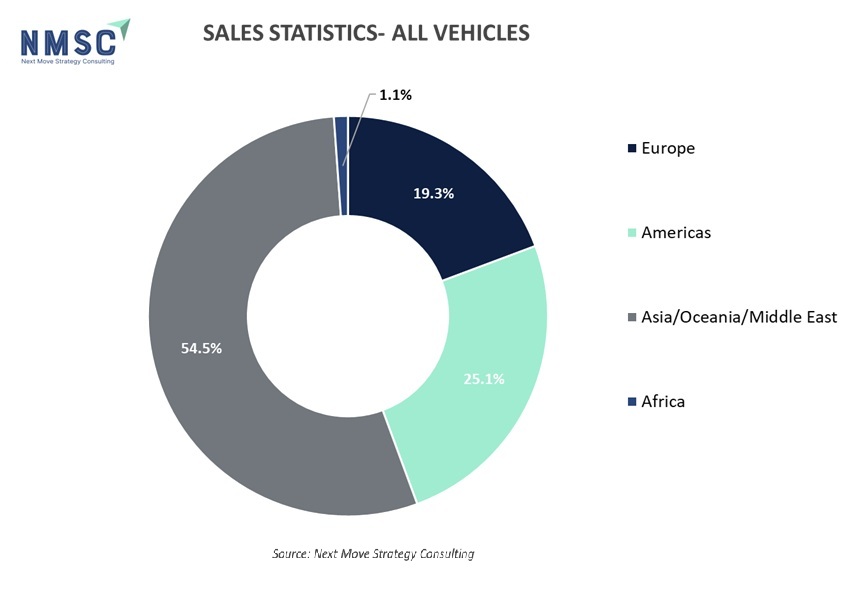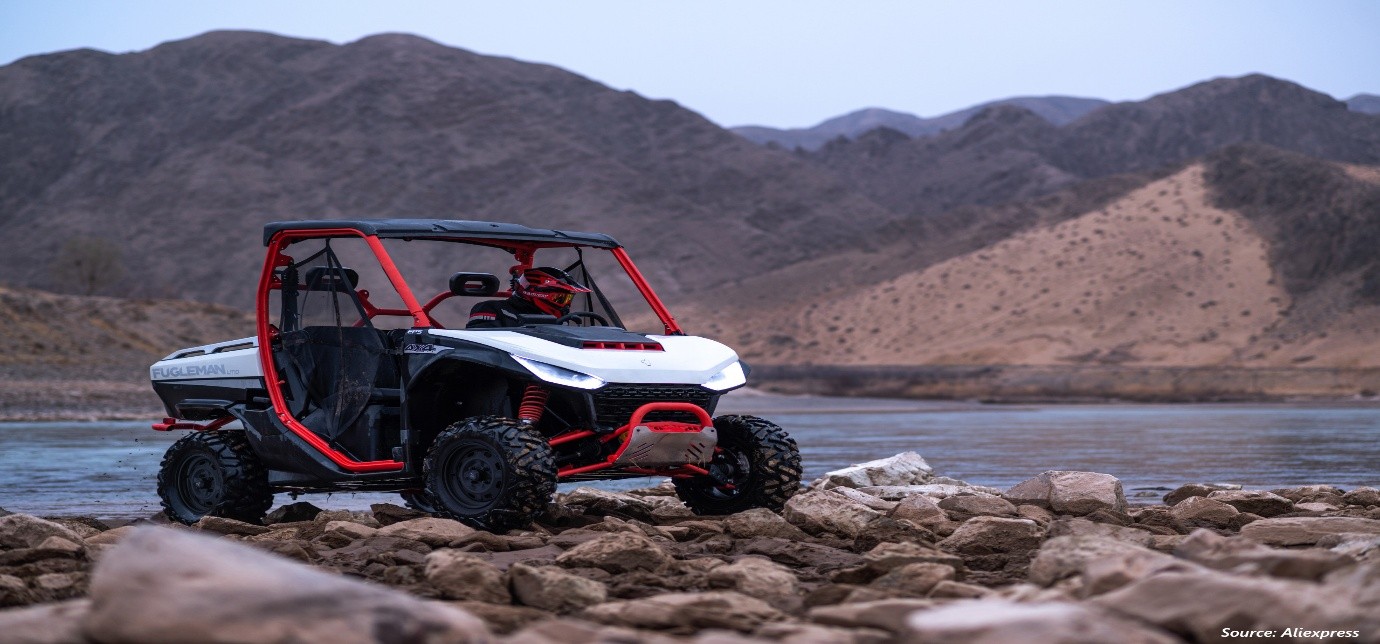Electric 4WD UTVs: Redefining Off-Road Mobility In Modern Age
17-Apr-2025

The 4WD Utility Task Vehicle (UTV) Market is undergoing a revolution, spurred on by the global trend towards electrification. As outdoor users, industries, and farmers look for sustainable, high-performance substitutes, electric 4WD UTVs are on the verge of becoming the new off-road mobility phenomenon.
These UTVs provide zero emissions and instant torque, lower maintenance, and operating costs, making them a popular choice among commercial as well as recreational users. Year after year, the production of electric vehicles, including 4WD UTVs has been steadily increasing and manufacturers are putting millions of dollars into electric models to meet the growing consumer demand and reshape the industry.
Rise of Electric 4WD UTVs
Traditionally, utility terrain vehicles feature a gas or diesel engine, that are tough and reliable. However, with the growing threat of carbon emissions, rising fuel prices, and sustainability in the environment, demand for electric 4WD UTVs is rising at a fast pace nowadays.
Indicators in use prove electric UTVs are modern, tough, powerful, and high-tech vehicles made for rugged terrain and heavy use. The leaders such as Polaris, Can-Am, Honda, and Textron are leading the development of electric UTVs that are comparable and, in a few instances, superior to gasoline-powered models.
Curious about the 4WD UTV Market? Grab your FREE Sample!
Advantages of Electrification in the 4WD UTV Market
Several factors are fueling the rise of electric 4WD UTVs, making them a preferred choice for off-road adventures, industrial applications, and agricultural work.
- Environmental Regulations & Sustainability Goals
Governments across the globe tighten emission laws, forcing industries to migrate toward greener choices. This has made electric UTVs far more accessible and cost-effective than ever before, with many regions providing incentives and tax benefits for electric vehicle (EV) adoption.
Carbon neutrality and green initiatives are spurring industries from agriculture to mining and forestry to cleaner, battery-powered alternatives. The world is realizing the need to curb climate change, and as that reality sets in, more electric UTVs is expected to go into service.
- High Torque & Instant Power
Electric UTVs also offer immediate torque compared to gas-powered UTVs that must wind up for torque, producing the instant power that greatly enhances acceleration and control. This is essential for rough terrain, steep inclines, and heavy towing, something that makes electric UTVs perfect for rough and rugged work settings.
For example, recently CFMOTO Australia launched the new U10 pro UTV range that delivers an impressive 94.5 Nm of peak torque, making it well-suited for tasks requiring substantial low-end power, such as towing and hauling heavy loads. Therefore, whether its rain or shine, mud or snow, electric 4WD UTVs have great traction and handle smoothly on rocky gravel roads.
-
Low Maintenance & Long-Term Cost Savings
One of the greatest benefits of electric UTVs is reduced maintenance needs. With fewer parts that move, no oil changes, no spark plugs, and no exhaust systems, owners can save thousands of dollars in maintenance over the years. Also, electricity is significantly cheaper than gasoline, that lowers operational costs even further.
- Silent & Efficient Operation
Unlike traditional UTVs that produce loud engine noise, electric models operate almost silently. This makes them ideal for hunting, wildlife research, and farm work, where noise reduction is essential. In industrial settings, silent operation enhances communication and safety among workers. Additionally, with efficient power usage, electric UTVs provide longer working hours on a single charge, improving productivity across various sectors.
Innovations in Electric 4WD UTVs
The electrification of the 4WD UTV market is not just about replacing gas engines with batteries; it’s about enhancing the entire off-road experience. Manufacturers are integrating cutting-edge technology to improve performance, safety, and convenience.
Smart Drive Systems & AI Integration
Many modern electric UTVs come equipped with AI navigation systems and GPS tracking, in addition to several other features that include drive modes adaptive to terrain. For instance, in November 2024, Massimo Group launched its latest 2025 UTV model, the Buck 550-6 Crew with an upgraded GPS tracking navigation system. This adjust how power should be delivered depending on the conditions on the ground to make handling easier and more efficient.
Solar & Regenerative Charging
With a rising consciousness towards sustainable off-road adventures, some brands are pioneering solar-powered UTVs while others design charging infrastructure that helps refill batteries during extensive trips.
Polaris Inc. opened the first public electric vehicle charging network in the United States specifically dedicated to off-road vehicles, comprising UTVs, in June 2024. This system will be particularly useful to off-road enthusiasts who are frequently far away from traditional charging stations.
Advanced Suspension & Towing Capabilities
Electric UTVs have novel self-adjusting suspension systems that automatically adapt to complex terrains. This enables higher towing capacity, and high-torque electric motors help pull more weight against conventional gas-powered ones.
For example, in September 2024, Volcon, Inc. launched the electric H1 Electric UTV with high-level suspension system. It is designed for true off-road enthusiasts, commercial operations, and adventure enthusiasts. 4WD UTVs are thus a great option for farmers, ranchers, and construction workers who require power-packed performance on a daily basis.
Longer Battery Life & Fast Charging
Battery range has been a major concern in the past, and new electric UTVs now offer extended ranges of 100+ miles per charge. Fast charging capabilities minimize downtime, allowing vehicles to be fully recharged in just a few hours.
For instance, in September 2023, Greenworks launched an UTV with lithium-ion battery integration to build a more powerful future with clean energy. The expansion of charging infrastructure in rural and industrial areas further supports the mainstream adoption of electric UTVs.
The Future of the 4WD UTV Market
The rapid electrification of the 4WD UTV market is an industry trend that is anticipated to dominate within years. With advances in battery efficiency, smart technology, and government incentives that are also seen in the automotive industry, the electric UTV is expected to make gas-powered models in this category extinct at an ever-quickening pace. Polaris, Can-Am and other manufacturers are pouring tens of millions into next-gen electric UTVs.
Electric UTVs across multiple sectors will see substantial growth in the market as charging infrastructure continues to expand and battery costs continue to fall. Designed for everything from recreational off-roading to farming to construction and law enforcement, electric 4WD UTVs are smarter, stronger, and more sustainable than their fossil-fuel alternatives. With zero emissions, instant torque, and reduced maintenance costs, they offer an unmatched combination of performance and sustainability.
Conclusion
Electric 4WD UTV that are integrated with the recent technological advancements are set to revolutionize the UTV industry for the coming decades. The increasing emphasis on reducing carbon footprints and more stringent emission legislation is likely to make electric UTVs the vehicle of preference for recreation and commercial use in the years to come.
Enhancements to range, charging speed, and durability increases their useability for all kinds of tasks, whether it's off-road adventures or farming, construction, and general utility work. With innovation on the rise, electric 4WD UTVs will take off-road mobility by storm, providing a cleaner, quieter, and more efficient alternative to typical gasoline UTVs.
ABOUT THE AUTHOR
 Swagata Sarkar is an enthusiastic and dedicated researcher with 3 years of experience. She is committed to helping clients navigate complex business challenges by offering actionable insights through thorough research. Swagata has a strong interest in various sectors, including Agriculture, Energy & Power and ICT & Media and she aims to deliver valuable perspectives in these areas. Beyond her research, Swagata also enjoys articulating her thoughts through articles and blogs while finding solace in literature and art, often immersed in reading and painting. The author can be contacted at [email protected]
Swagata Sarkar is an enthusiastic and dedicated researcher with 3 years of experience. She is committed to helping clients navigate complex business challenges by offering actionable insights through thorough research. Swagata has a strong interest in various sectors, including Agriculture, Energy & Power and ICT & Media and she aims to deliver valuable perspectives in these areas. Beyond her research, Swagata also enjoys articulating her thoughts through articles and blogs while finding solace in literature and art, often immersed in reading and painting. The author can be contacted at [email protected]










